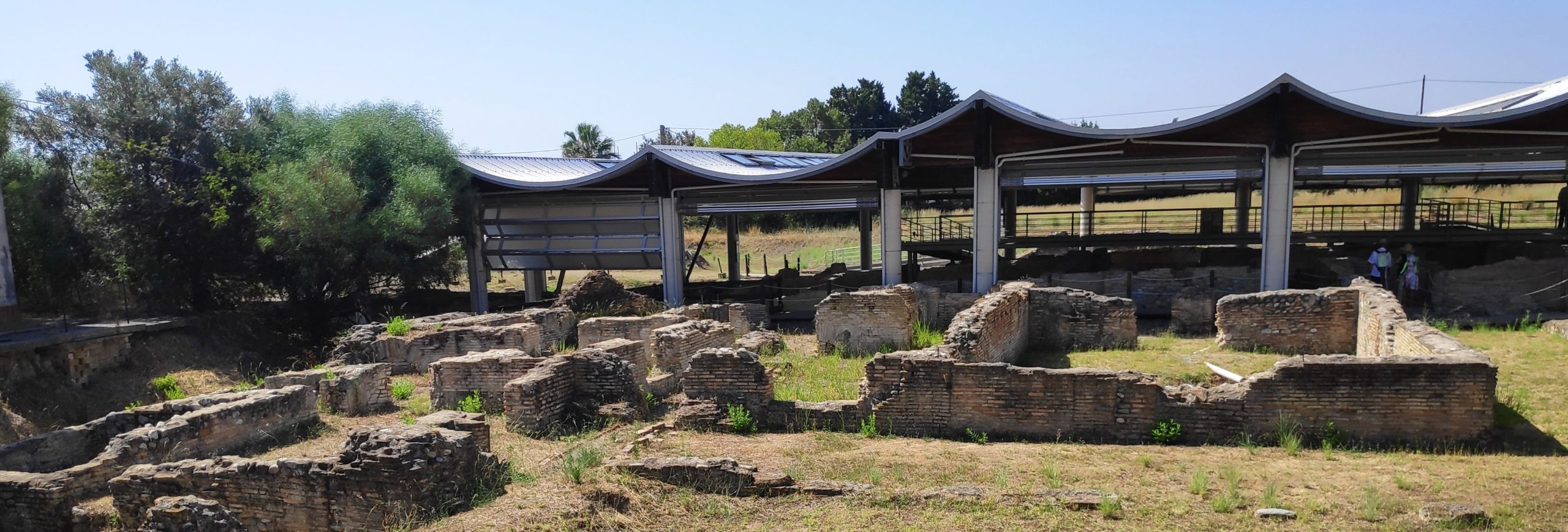Timetravelrome in collaboration with Michel Gybels
The Roman Villa of Casignana is located in the province of Reggio Calabria. The original structure dates back to the 1st century AD and its most significant phase is represented by a major renovation that took place in the 4th century. It was later abandoned in the 5th, but traces of frequentation are visible up to the 7th century.
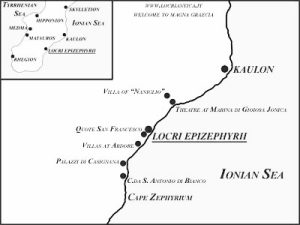
Location of the Villa Casignana on the sea coast of Calabria. Link to the source: www.locriantica.it
The Maritime Villa
The villa stood on the ancient road connecting Locri Epizefiri and Rhegion (Reggio Calabria). Due to this location on the road, it was initially thought that the Villa was connected to a statio, or that a statio had developed into a villa. However, the discovery in the 90’s of a residential sector with a facade open to the sea and connected to the thermal baths by a large peristyle have proven that the complex represents a residential-type maritime villa, belonging to an extremely wealthy owner.
Due to its richness, the quality and the state of conservation of the structures, the Villa of Casignana is one of the most important Roman archaeological complexes in southern Italy.
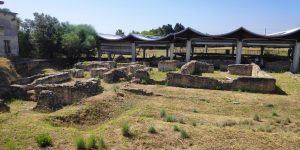
View on the archaeological site. By Marcuscalabresus – Own work, CC BY-SA 4.0.
The History of the Discovery
The first documentation of the Villa’ remains are dating back to 1873 – the discovery was made on the occasion of the construction of the railway line on the Ionian coast of Reggio. The first documented finds date back to 1956, when a marble column was occasionally found. Then, the full archaeological area was discovered in 1963, following work for the construction of an aqueduct, near the road. After this date, the villa was systematically excavated and researched. Since 1998, the site has been managed by the municipality of Casignana which, with the acquisition of the neighboring lands, was able to significantly expand the protected area. Today, thanks to the vast archaeological excavations, the Villa and a large private thermal complex were brought to light.
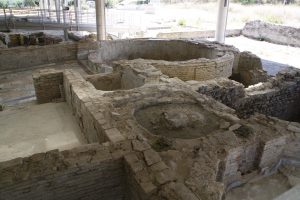
Lateral view on the room 25 of the Baths. Photo by Michel Gybels.
The Archaeological Site
The villa, positioned perpendicular to the coastline, was built between the 1st and 3rd centuries AD and then restructured at the beginning of the 4th century with a division into two main sectors: A and B to the west and D and H to the east, separated by a peristyle.
The picture below highlights the general plan of the villa: (A – Nymphaeum; B) – Thermal complex including two Baths; C) – Southern Baths; D) – Residential complex; E) – Central courtyard with a portico that overlooks the sea; F) – Large southern building; G) – northern porticoed building; H) northern building. Note that the North direction on this plan is on the right side.
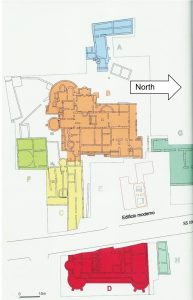
The map of the archaeological site. Source: “Ville residenziali nell’Italia tardoantica: Dati recente e nuove prospettive di ricerca”.
The residential wing must have been splendid, suitable for an important person, a magistrate or a patrician. The owner decided to build two private thermal facilities next to his Villa, adorned with mosaic floors of great value. In addition to floor mosaics, frescoes and wall marble veneers, it was highly likely that Villa at Palazzi di Casignana was decorated with marble statues, all kinds of movable furniture and artworks.
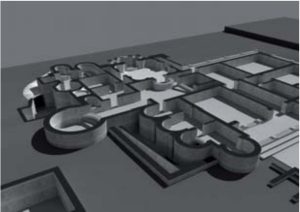
Partial 3D reconstruction of the site. Source: “Modellazione multiscala e multicanale per la comunicazione del patrimonio culturale: la Villa Romana di Palazzi di Casignana”.
Mosaics of the Baths and the Villa
The Baths and the Villa are characterized by an exceptional size and decorative apparatus: more than twenty rooms feature geometric and figurative mosaics and the discovery of glass paste tesserae also suggests the existence of a decoration of the vaults of the main rooms.
One of the most beautiful and refined mosaics can be seen in the two frigidaria of the Baths complex. In particular, mosaics of the “hall of the Nereids” in the frigidarium of the Eastern Baths, dated to the 3rd century, depict a marine thiasos (“thiasos” – a group of worshippers of a god) with four female figures riding a lion, a bull, a horse and a tiger ending with a fish tail. The room has an octagonal plan and has four apse sides, it also has two cold water pools.
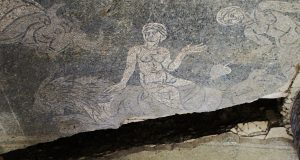
Mosaic in the frigidarium of the Eastern Baths (room 9) with a Nereid on a lion. Photo by Michel Gybels.
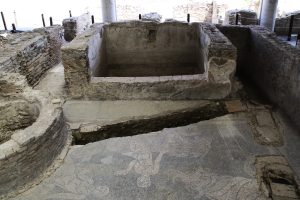
General view on the frigidarium of the Eastern Baths. Photo by Michel Gybels.
The Room 25 represents the continuation of the room 9, and also served as the frigidarium of the Eastern Baths. This room is paved with an exquisite marble opus sectile, and features walls covered with marble veneers some of which still stand in place. The smaller tub located on the south side of the room was used for cold baths.
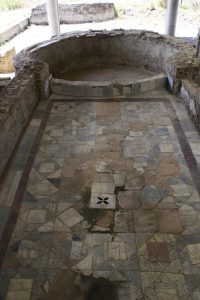
The Room 25 of the Eastern Baths. Photo by Michel Gybels.
The frigidarium of the Western Baths (Room 12) is decorated with geometrical mosaics. It was one of the most opulent and elegant rooms of the entire villa measuring ca. 6 m. x 6 m. The walls of the room were covered with marble veneers, portions of which are still visible today. The central area of Room 12 is paved with an elegant mosaic composed of white, black and green tesserae forming a perspective cube motif. A great quantity of light blue glass tesserae was
found in the room’s debris, suggesting the presence of a blue glass mosaic decorating the vaulted ceiling. The effect must have resembled a blue sky arching above the room, which was enhanced by the reflection of the water contained in the two tubs also situated in this beautiful room.
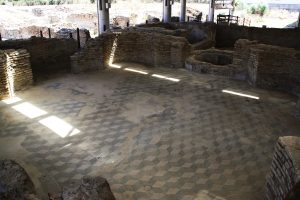
The frigidarium of the Western Baths (Room 12). Photo by Michel Gybels.
The calidarium of the Eastern Baths, with its hypocaust heating system, also has an octagonal plan and a mosaic floor in small tiles.
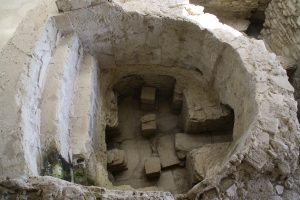
The hypocaust of the calidarium of the Eastern Baths. Photo by Michel Gybels.
The floor of Room 36 – which makes part of the Estaren Baths calidarium – rests on suspensurae and is paved with a complex, polychrome geometric mosaic.
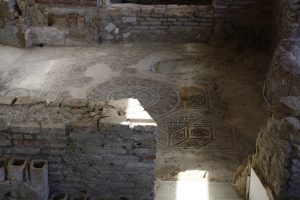
Polychrome mosaic of the calidarium of the Eastern Baths (Room 36). Photo by Michel Gybels.
The floor of the room 24 – Calidarium of the Western Baths – was also built on suspensurae and is decorated with a geometric tesselatum. Remains of many glassy tesserae found in the area suggest the presence of another mosaic on the ceiling. On the photo of this room one can also see “tubuli” – tubes running up the walls to distribute heat.
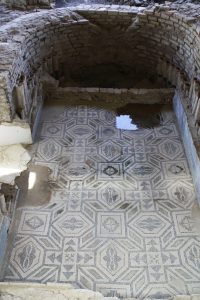
Calidarium of the Western Baths. Photo by Michel Gybels.
The complex contains a beautiful rectangular hall (Room 7) – a dining room. The floor of Room 7 was paved with an elegant polychrome geometric mosaic featuring a four star motif. This room was identified as a triclinium, or dining room, as it is located in a particularly privileged position near the Courtyard and it has a view of the garden on the east side.
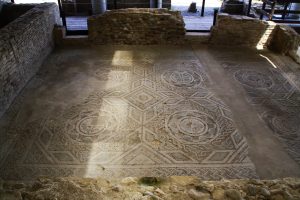
Room 7 – perhaps a dining room. Photo by Michel Gybels.
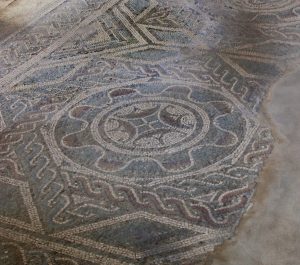
Mosaic pattern of the room 7. Photo by Michel Gybels.
On the opposite side of the road is located the residential part with numerous articulated rooms and a large courtyard.
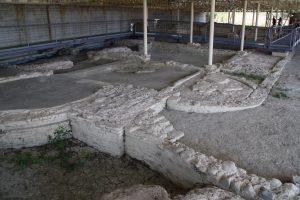
Room “T” of the residential part of the Villa. Photo by Michel Gybels.
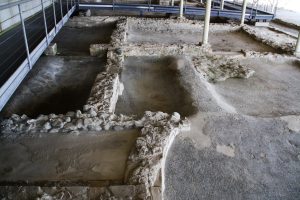
Mosaic Floors in the residential part. Photo by Michel Gybels.
In this residential part of the villa visitors can admire mosaic of the so-called “four seasons” hall. The floor of this room, used for banquets, is decorated with the personified faces of autumn, winter, spring and summer.
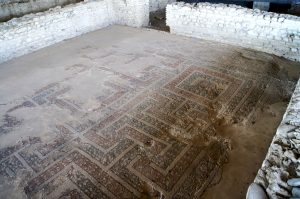
Villa romana di Casignana (room B) By Rjdeadly – Own work, CC BY-SA 4.0.

“Four seasons” mosaic – personification of the summer. By Marcuscalabresus – Own work, CC BY-SA 4.0.
The eastern facade of the Villa di Casignana’ residential area, which looks out towards the sea, represented a portico possibly flanked by two towers. The ground level structures of the portico are preserved, including the lower portions of the walls and parts of its polychrome floor mosaic.
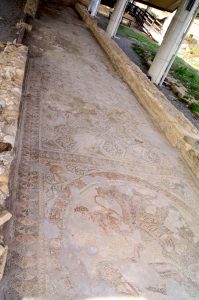
Polychrome mosaics of the portico. Source: By Rjdeadly – Own work, CC BY-SA 4.0.
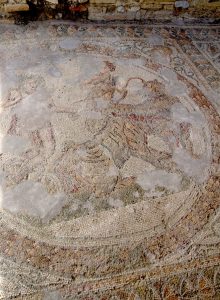
Detail of the mosaic in he Portico representing the “Indian Triumph of Dionysus“. By Rjdeadly – Own work, CC BY-SA 4.0,
The site of Casignana is considered the largest of those discovered so far in Calabria, and its importance is significant throughout southern Italy.
Sources:
“The Monumental Villa at Palazzi di Casignana and the Roman Elite in Calabria (Italy) during the Fourth Century AD”. Dissertation by Maria Gabriella Bruni, University of California.
“Modellazione multiscala e multicanale per la comunicazione del patrimonio culturale: la Villa Romana di Palazzi di Casignana”, Atti 13a Conferenza Nazionale ASITA – Bari 1-4 dicembre 2009
“Ville residenziali nell’Italia tardoantica: Dati recente e nuove prospettive di ricerca”, Carla Sfameni. Piazza Armerina Villa del Casale. Scavi e studi nel decennio 2004-2014, edited by Pensabene Patrizio, Barresi Paolo, pp. 231–256. Roma: L’Erma di Bretschneider, 2019
Source of the header picture: Scavi archeologici non coperti della villa romana di Casignana, By Marcuscalabresus – Own work, CC BY-SA 4.0.
